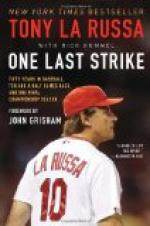And now West and Whipple, both excellent players, and sworn enemies of the links, were fighting it out, and on this round depended the possession of the title of champion and the ownership for one year of the handicap cup, a modest but highly prized pewter tankard. Medal Play rules governed to-day, and the scoring was by strokes.
[Illustration: Plan of Hilton Academy Golf Links]
Whipple reached the first green in one stroke, but used two more to hole-out. West took two short drives to reach a lie, from which he dropped his ball into the hole in one try. And the honors were even. The next hole was forty yards longer, and was played either in two short drives or one long drive and an approach shot. It contained two hazards, Track Bunker and High Bunker, the latter alone being formidable. Whipple led off with a long shot that went soaring up against the blue and then settled down as gently as a bird just a few yards in front of High Bunker. He had reversed his play of the last hole, and was now relying on his approach shot for position. West played a rather short drive off an iron which left his ball midway between the two bunkers. Whipple’s next stroke took him neatly out of danger and on to the putting green, but West had fared not so well.
There was a great deal of noise from the younger boys who were looking on, much discussion of the methods of play, and much loud boasting of what some one else would have done under existing circumstances. West glanced up once and glared at one offending junior, and an admonitory “Hush!” was heard. But he was plainly disturbed, and when the little white sphere made its flight it went sadly aglee and dropped to earth far to the right of the green, and where rough and cuppy ground made exact putting well-nigh impossible. Professor Beck promptly laid down a command of absolute silence during shots, and some of the smaller youths left the course in favor of another portion of the campus, where a boy’s right to make all the noise he likes could not be disputed. But the harm was done, and when play for the third hole began the score was: Whipple 7, West 8.
Even to one of such intense ignorance of the science of golf as Joel March, there was a perceptible difference in the style of the two competitors. Outfield West was a great stickler for form, and imitated the full St. Andrews swing to the best of his ability. In addressing the ball he stood as squarely to it as was possible, without the use of a measuring tape, and drove off the right leg, as the expression is. Despite an almost exaggerated adherence to nicety of style, West’s play had an ease and grace much envied by other golf disciples in the school, and his shots were nearly always successful.
Whipple’s manner of driving was very different from his opponent’s. His swing was short and often stopped too soon. His stance was rather awkward, after West’s, and even his hold on the club was not according to established precedent. Yet, notwithstanding all this, it must be acknowledged that Whipple’s drives had a way of carrying straight and far and landing well.




